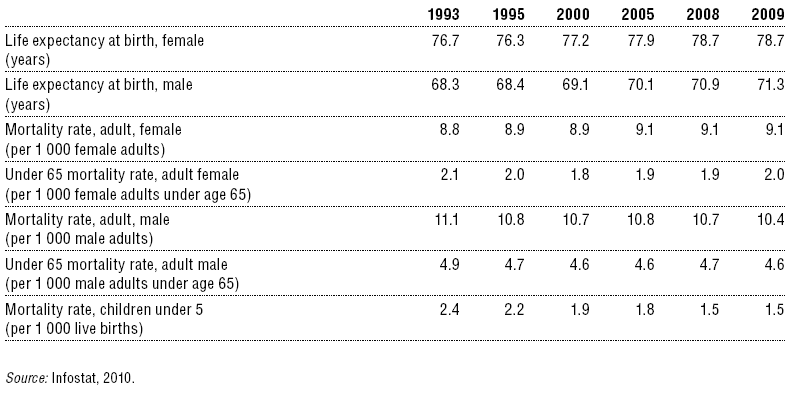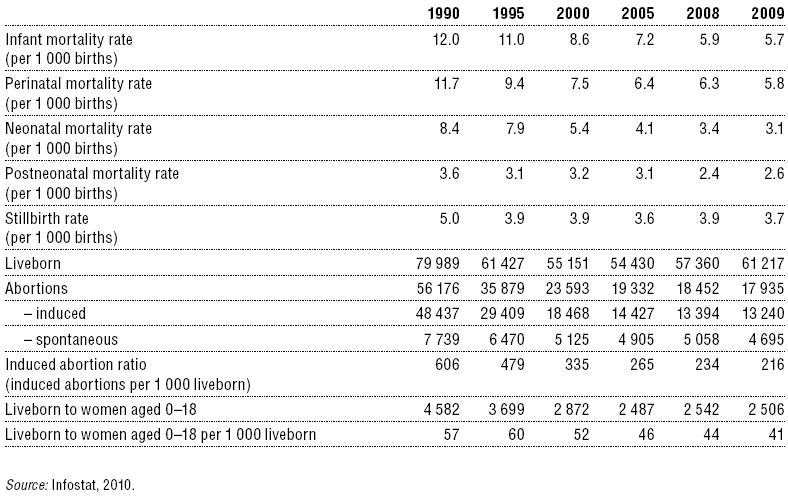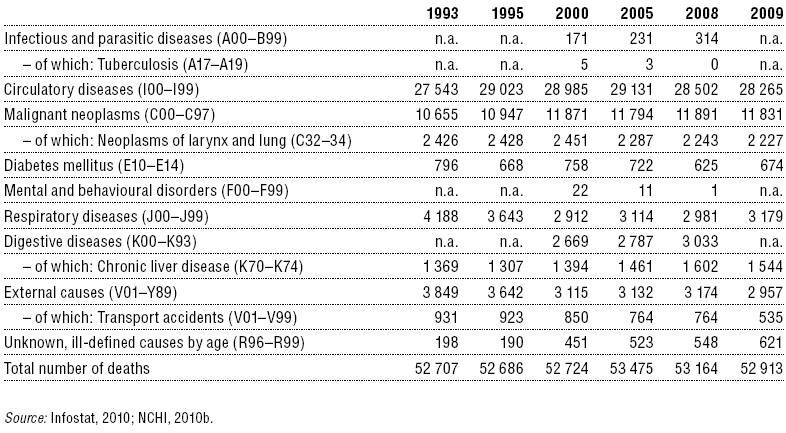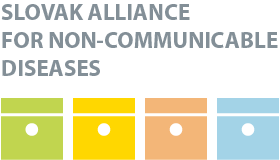—
HPI Network > HPI - Health Policy Institute > Health System in Slovakia > 1. Introduction > 1.4 Health status
1.4 Health status
Wednesday, 04. May 2011, 21:12 — HPI
|
1.3 Political context |
Introduction – Organization – Financing – Resources – Provision – Reforms – Assessment – Conclusions – Appendices |
2. Organization and governance |
The trend in average life expectancy at birth in Slovakia shows an increase. Female life expectancy at birth has increased by 2.0 years since 1993 and reached 78.7 years in 2009. During the same period, male life expectancy at birth has increased by 3.0 years and reached 71.3 years. This leaves a significant difference of 7.4 years in 2009 in average life expectancy in favour of women. The child mortality rate has been continuously decreasing from 2.4 per 1000 in 1993 to 1.5 in 2009 (see Table 1.3). A continuing unfavourable mortality rate among men of middle age (30–55 years) is observed, which in 2008 was almost three times higher compared to the rate among women (not shown in Table 1.3, see Infostat, 2010). In 2007, the health-adjusted life expectancy (HALE) in Slovakia was 67 years, with large differences for men (64 years) and women (70 years) (Table 1.4).
Table 1.3: Mortality and health indicators

Table 1.4: HALE at birth in years

Infant mortality is an important indicator associated with quality of health care. Infant mortality was roughly halved from 12.0 per 1 000 births in 1990 to 5.7 in 2009 (Table 1.5). Perinatal mortality has also declined by around 50% to 5.8 per 1000 live births in 2009, mainly as a result of decreasing neonatal mortality (Table 1.5). All indicators related to child mortality are demonstrating a long-term decline. Although progress has been made for most indicators, and Slovakia is comparable to or better than the EU12 average, Slovakia still falls significantly behind when compared to EU15 countries. For a more detailed international comparison see section 7.3.
Induced abortions have declined substantially. While there were 606 abortions per 1000 live births in 1990, there were only 216 in 2009. Slovakia’s liberal legislation allows an abortion up to the 12th week of pregnancy without stating a reason. Until 2008, legislation allowed abortion up to the 24th week of pregnancy in case of a fetal genetic malformation. The number of children born to mothers under the age of 18 has been in a continuous decline. Calculated per 1000 live births, the level decreased from 57 in 1990 to 41 in 2009 (Table 1.5), while this level peaked at 71 children per 1000 live births in the early 1990s (not shown in Table 1.5). According to a survey (FOCUS, 1997), more than one-third of 17-year-old girls and half of 18-year-old girls have engaged in sexual activity. One-third of girls and women used a contraceptive during their first sexual encounter. The likelihood of using a contraceptive during their first sexual encounter increases significantly with education. The education of a girl’s mother and her role in explaining planned parenthood issues is also an important factor.
Table 1.5: Selected indicators of maternal and neonatal health

The most frequent causes of death in Slovakia are lifestyle-related, mainly non-communicable diseases (Table 1.6), including cardiovascular diseases (52.9%), cancer (22.1%), gastrointestinal diseases (5.9%) and respiratory diseases (5.5%).
Table 1.6: Main causes of death (ICD-10 classification)

The Slovak population has 100% access to drinking water. Regarding infrastructure, up to 86.3% of the population has a drinking water service connection. Throughout 2002–2006 this share has risen by 2.4 percentage points (see Table 1.7). Also 56.4% of the population is connected to the public sewerage system. A large proportion of households have their own sewage tank.
Table 1.7: Access to safe water (%)

News
The amendment of the Decree on emergency medical service
Health insurance companies returned over 400 thousand €
The HCSA received 1,647 complaints last year
A half million people will earn more
Most of public limited companies ended in the black
Debt of hospitals on premiums has grown to nearly € 105 MM
Slovak health care may miss € 250 million next year
Profits of HIC amounted to € 69 mil. last year
Owners of Dôvera paid out money but did not paid taxes
Like us on Facebook!
Our analyses
- 10 Years of Health Care Reform
- New University Hospital in Bratislava
- Understanding informal patient payments in Kosovo’s healthcare system
- Analysis of waiting times 2013
- Health Policy Basic Frameworks 2014-2016
- Analysis of informal payments in the health sector in Slovakia
- Serbia: Brief health system review
developed by enscope, s.r.o.
